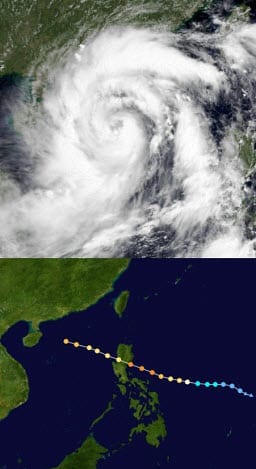According to catastrophe modeling firm AIR Worldwide, Typhoon Utor slammed into the northern Philippine island of Luzon on Monday, August 12, at around 3:00 pm local time (7:00 UTC) with 10-minute sustained winds of 175 km/h (109 mph, JMA), gusts of up to 210 km/h (130 mph, JMA), and waves up to 2.5 meters high. Utor’s strength at landfall was a Category 4 Super Typhoon, but it weakened to a Category 2 as it moved over the island. Once again over warm open waters of the South China Sea (with temperatures of 30°C, about 0.5–1.0°C higher than normal) and amid low wind shear conditions (5-10 knots), the storm is expected to intensify as it moves toward the southeast coast of China, according to the JMA. AIR does not expect significant insurance losses in the Philippines from this event because cyclone coverage typically excludes loss or damage from flood, tidal wave, high water, or overflow, regardless of whether it is caused by high winds.
“Utor, the strongest tropical cyclone of 2013 thus far, toppled power lines and dumped heavy rain across mountains, cities and food-growing plains,” said Jason Butke, senior scientist at AIR Worldwide. “The typhoon destroyed nearly 80% of the infrastructure in the town of Casiguran (population 24,000). According to NASA’s Tropical Rainfall Measuring Mission (TRMM) satellite, precipitation in the wake of the storm is on the order of 150-250 mm across northern Luzon. Manila, the capital of the Philippines, experienced moderate rain, but no flooding was reported.”
Butke continued, “An average of six tropical cyclones make landfall in the Philippines annually with another three passing close enough to cause loss. The Philippines experience tropical cyclone activity in every month, with peaks in July and November. Super typhoon landfalls occur, on average, twice every three years. Weak steering currents slowly move storms over the islands, resulting in heavy precipitation and flooding. Damage to property in the Philippines is dominated by flood through all but the highest return periods. Since the eastern coast is relatively unpopulated, insured wind losses tend to be low.”
another three passing close enough to cause loss. The Philippines experience tropical cyclone activity in every month, with peaks in July and November. Super typhoon landfalls occur, on average, twice every three years. Weak steering currents slowly move storms over the islands, resulting in heavy precipitation and flooding. Damage to property in the Philippines is dominated by flood through all but the highest return periods. Since the eastern coast is relatively unpopulated, insured wind losses tend to be low.”
Utor is currently off the northwestern coast of Luzon and is moving west-northwest at about 22 km/h across the central part of the South China Sea, in the general direction of Guangdong province in China. The storm is gathering strength and is expected to strike Wednesday afternoon southwest of Hong Kong, according to the JMA.
According to AIR, in the Philippines, lighter materials, such as wood frame with galvanized iron or aluminum roofs are often used for residential buildings in rural areas. In contrast, urban residential structures are generally made of concrete block with metal roofs, although hollow concrete is also used. Masonry residences can also be found in the cities, which also have many high-rise apartments made of steel construction. Masonry is often used for smaller commercial establishments although the majority of all commercial and industrial buildings are reinforced concrete or steel. Building codes are not strictly enforced. In the Luzon area one to two story buildings of mixed construction (concrete and wood) are common. Houses in coastal regions of Guangdong are commonly masonry or reinforced concrete with clay tile roofs, which perform reasonably well in the face of typhoon winds. As is often the case with China typhoons, however, flooding is a major concern; with much of the population located near waterways and along the coast, many homes and businesses are at risk.
According to AIR, the northern area of Luzon, where Utor hit, is not heavily insured due to low commercial and industrial activity.
AIR will continue to monitor the situation and will provide updates as warranted.
